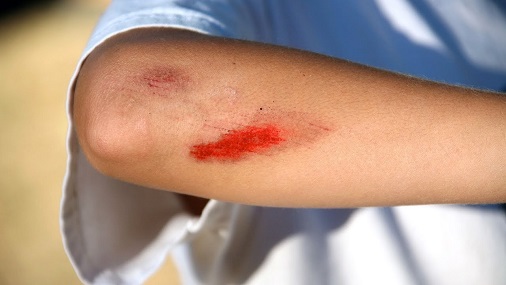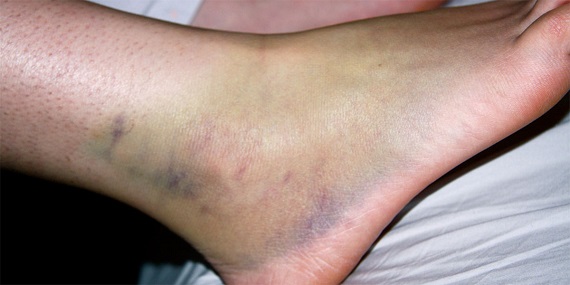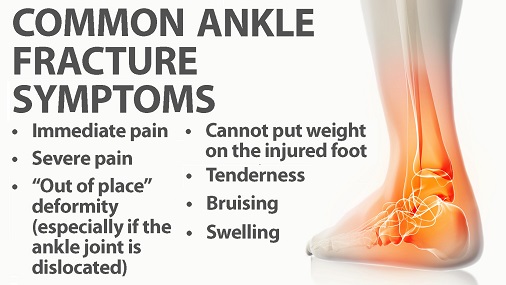Be Prepared
Anyone who throws their leg over a bike regularly will tell you, there’s going to come a time when you fall off. Most of the time, you’ll get away with nothing more than an amusing story, but here’s some things to think about when it’s a little worse:

Any damage to the skin should be cleaned as soon as possible with clean water, which is another good reason to carry a drinks bottle filled with lovely fresh water. Then gently pat the injury dry, with a clean lint-free cloth, and if available, use an antiseptic cream and cover with a dressing.
If it’s a bad cut, first stem the bleeding with a clean cloth, and only use your hands as a last resort. If the bleeding doesn’t stop quickly, keep the injury raised and cleaned and covered then seek medical assistance.

Although sometimes very painful, these not too serious. It is generally advised not to put weight or pressure on the damaged muscles for a day or two, to allow for recovery. This is particularly important for a sprain. So you are almost certainly going to need to arrange alternative transport.
Be sure to rest a sprain for a few days, and begin gentle movement exercises when pain is reduced. See a physiotherapist if you can – the injury will heal, but it will be quicker if you don’t stress it too early.

If you suspect a fracture, it’s very important to keep the injured limb still. If you’re on your own, make sure you’re in a safe, comfortable position, then call for help.
If you’re helping another rider after a fall, try not to move them. Being still means you lose heat really quickly, even in mild conditions. Make sure that the injured person stays warm, and call medical help. Don’t let them eat or drink, just in case they need hospital treatment.
Fractures nearly always need hospital treatment, so make sure to have an x-ray and get the proper care if you suspect a fracture.

If you think a rider could have suffered a head injury, check their head for lumps or cuts, and if they were wearing a helmet, check it for damage. Remember they may not be aware they have hit their head, and don’t let them eat or drink in case they need hospital treatment. Even if they insist that they are OK to continue the ride, keep a close eye on them, and watch for signs of concussion.
Be aware that a rider who has hit their head may also have hurt their neck. If they are unconscious, check their airways are free and that their tongue is not blocking their throat. If the rider is vomiting, experiencing double visions or not breathing, call 999.
If you have hit your head, and later experience confusion, a bad headache, drowsiness or neck pain, get yourself checked out as soon as possible.
The recent Coronavirus pandemic has made us all more aware of the benefits of good hygiene practices, and these becomes even more important when administering first aid. Whether you’re abiding by social distancing measures or not, there are some principals that will ensure that transmission of infections is kept to a bare minimum.
- Always carry fresh drinking water. As well as keeping you hydrated, it can also be used to rinse a minor cut or graze.
- Carry your own basic first aid kit:-
- sterile gauze pad
- adhesive tape/plasters
- elastic bandage
- safety pins
- alcohol wipes or ethyl alcohol
- plastic non-latex gloves
- Other useful items
- a list of emergency phone numbers
- a foil blanket
- mouthpiece for giving CPR
Most of the above should fit comfortably into your jersey pockets, but if you’ve already stuffed those full of energy bars and inner tubes, a small under-saddle pack will fit everything you need, and will be easily accessible for anybody coming to your rescue.
But perhaps most importantly, make sure your phone is kept somewhere you can easily access it, and it is well protected in the event of a fall, because when things get serious, that may be your most vital equipment. Handlebar mounts, armbands and hip pockets all place your phone in a vulnerable position, meaning it might not be there when you most need it.
Be Aware
Riding in a group carries many additional responsibilities, whether it’s a lead ride or just a group of friends. You may have been cycling with the same friends many times, but would you know the things that matter about them in an emergency?
Of course, nobody wants to burden the other riders with their personal medical history, but there are occasionally some things that could save your life. Or at the very least some minor discomfort. If there is anything that would affect the treatment provided by the emergency services, in the event of you being incapacitated, make sure that the information is readily available.
The ICE wallet
Whatever the circumstances, you cannot 100% guarantee that your phone is going to be accessible/usable in the event of an accident, so we recommend carrying the following in a wallet, marked clearly In Case of Emergency:-
Other useful items
- your name, date of birth and blood type
- a list of emergency contact numbers, clearly stating your relationship
- a list of any prescribed medications you are currently taking
- details of any medical conditions or allergies
- your home address (and holiday address, if applicable)
- if you have appropriate insurance, the contact number for your bike’s recovery
Make sure at least one person in the group knows where you keep your ICE wallet, and if you do have any medical conditions, don’t be afraid to make others aware.
Be a Hero
A first aiders first thought is never about being a hero, it’s about helping a family member, a friend, or even a complete stranger, in a time of great need. But when all’s said and done, it is pretty heroic, and the world needs more heroes. The best part is, you don’t need to put on a special outfit.
There are many courses available, which will give you the knowledge and ultimately the confidence to offer first aid assistance, and potentially save a life. If you’d like to know where to find the best courses for cyclists, and the training involved, contact us at info@sofa-to-saddle.org.
